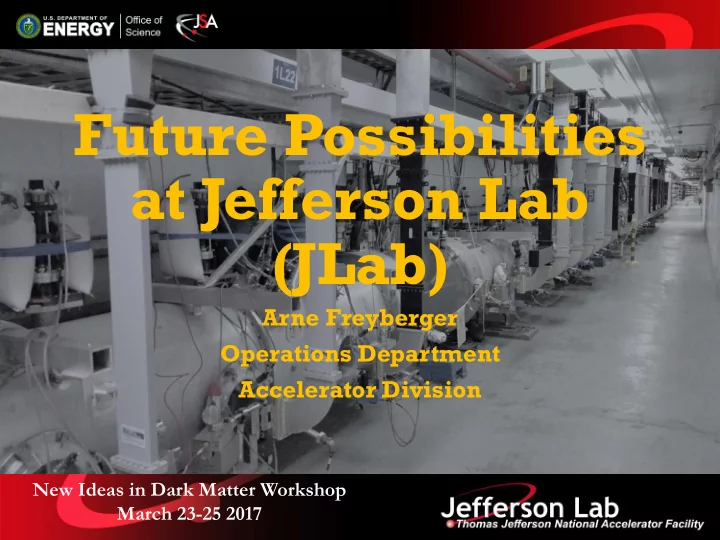

Future Possibilities at Jefferson Lab (JLab) Arne Freyberger Operations Department Accelerator Division New Ideas in Dark Matter Workshop March 23-25 2017
Outline • Jefferson Lab (JLab) • JLab Introduction • Continuous Electron Beam Accelerator Facility (CEBAF) • Low Energy Recirculator Facility (LERF) • Experimental End Stations (aka Halls) • JLab Experimental Program • Overview • JLab Dark Matter Experiments • Summary
Jefferson Lab Operated for the DOE Office of Science-Nuclear Physics Jefferson Lab Research : CEBAF • Experimental, computational and theoretical nuclear physics • Accelerator Science, SRF technologies and FEL • Radiation detectors and medical imaging • Cryogenic technology • 1530 users from 236 institutions and 31 countries SRF Cryogenics
12 GeV CEBAF Overview • Polarized electron beam (P>85%) • Four 249.5 (or 499) MHz interleaved beams, generating a 1497 MHz CW beam • CW SRF linacs Flexible extraction options for • • Design energy 2.2 GeV/pass: ABC, 1 st …5 th pass • 5 passes, 11 GeV (Halls A,B & C) Hall A & C 1 MW high power • • 5.5 passes, 12 GeV (Hall-D) dumps 4/24
CEBAF Injector Beam properties at the experimental target are determined by the beam properties in the injector. Four lasers used to create 4 • Gun Voltage 130 kV (upgrade • independent electron beams (249.5 planned to 200 kV) or 499 MHz repetition rate). Longitudinal Spin alignment at • Strained GaAs cathode produces • the hall achieved via Wien filters polarized beam with polarizations Large dynamic range in beam • over 85%. currents: nA’s to Halls B&D, Polarization is flipped (flip rate up to • 100’s m A to Halls A&C 1 kHz)
CEBAF GaAs Photocathode Evolution Bulk GaAs Strained GaAs: Superlattice GaAs: GaAs on GaAsP Layers of GaAs on GaAsP 100 nm 100 nm 14 Layers 2 μ m 625 μ m 350 μ m QE ~ 5%, 30 mA/W QE ~ 1%, 6 mA/W QE ~ 0.2%, 1 mA/W Pol ~ 35% @ 780 nm Pol ~ 75% @ 850 nm Pol ~ 85% @ 780 nm P e- 35% 35% 75% 75% 85% 89% I e- 30 m A 100 m A 50 m A 100 m A 150 m A 200 m A 1995 1998 1999 2000 2004 2012 2016 Spin Polarized Electron programs (particularly Parity Violation (PV) Users) have driven the need for improved performance over last 20+ years
Beam Parameters @ 12 GeV (2.2 GeV/pass) Vertical Emittance Horizontal Emittance Energy Spread 12 GeV CEBAF beam transport ready • to support the physics program Growth in emittance/energy spread due • to synchrotron radiation. Accelerator modeling of growth in • emittance/energy spread agrees well with expectations. 7/17
LERF (formerly FEL) • Consists of an energy-recovery superconducting linear accelerator of ~170 MeV • IR and UV wigglers exist to create laser light • The accelerator is fully operational, but suffers from lack of funded operating hours • Beam was successfully delivered to the DarkLight in August 2016 • LERF is fully operational • Only superconducting energy recovery linac in the world • LERF will operate for DarkLight experiment • Still seeking other programs and stable operating funds
LERF and CEBAF Beam Parameters LERF CEBAF Max. Energy 170 MeV 11 GeV (ABC) 12 GeV (D) Duty Factor CW CW Max. Beam Power >1 MW 1 MW Bunch Charge (Min-Max) 60-135 pC 0.004 fC – 1.3 pC Repetition Rate on Target 4.68 - 74.85 MHz 31.2 – 499 MHz Nominal Hall Repetition Rate 74.85 MHz 249.5 MHz Number of Exp. Halls 1 4 Max. Number of Passes 1 5.5 Emittance (geometric) at full 50 nm-rad(X)/ 30 nm-rad(Y) 3 nm-rad(X)/1 nm-rad(Y) energy @ 135 pC Energy Spread at full energy 0.02% 0.018% Polarization None >85%
End Station D Linearly polarized g -beam g -Polarization
End Stations A, B & C Hall B Hall C Hall A CLAS12 Hadron SHMS Tracker HRS + SBS calorimeter Scattering chamber CH2 analyzer Chiral symmetry broken, confinement occurs PDFs, TMDs, GPDs How does QCD lead to confinement? Study confinement forces Quarks attain masses dynamically Elastic and resonance form factors Transition is driven by baryon excitations Search for missing baryons
JLab Approved Experiments • APEX (Hall A) HPS (Hall B) DarkLight (LERF) • MOLLER (Hall A) BDX (Hall A Dump, parasitic not on plot)
Dark Matter @ JLab: M XX’ > A’ APEX (Hall-A) HPS (Hall-B) DarkLight (LERF)
Dark Matter @ JLab: M XX’ < A’ BDX (Hall-A)
Dark Matter @ JLab: sin 2 q W • Parity violated experiment with unprecedented precision • Standard Model expectation: A PV = 36 ppb (@ Q 2 = 0.0056 GeV/c 2 ) • d A PV = 0.74 ppb • Agreement with SM places limits on dark Z interference.
Summary The JLab electron beam facilities, CEBAF and LERF, are actively being used to search for Dark Matter. Enabling beam properties include: • Low beam halo (HPS, DarkLight) • Beam stability • High beam polarization and parity quality • CW beam • Large dynamic range in bunch Aleksejevs et. al. (arXiv:1603.03006v1) charge (beam current) • Beam energies from 100 MeV up to 12 GeV
Backup
Parity Quality Beam (PQB) Parameters
Parity Quality Beam: Accelerator Perspective
Recommend
More recommend